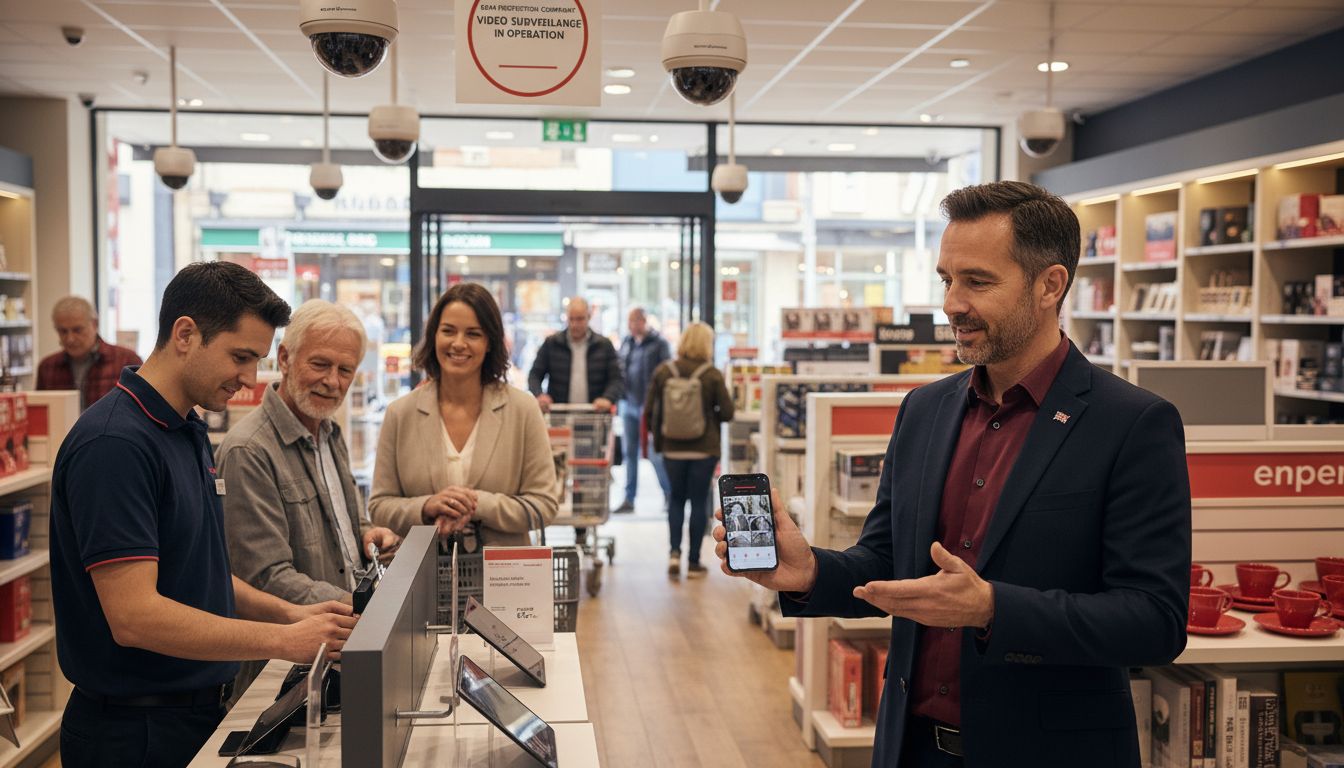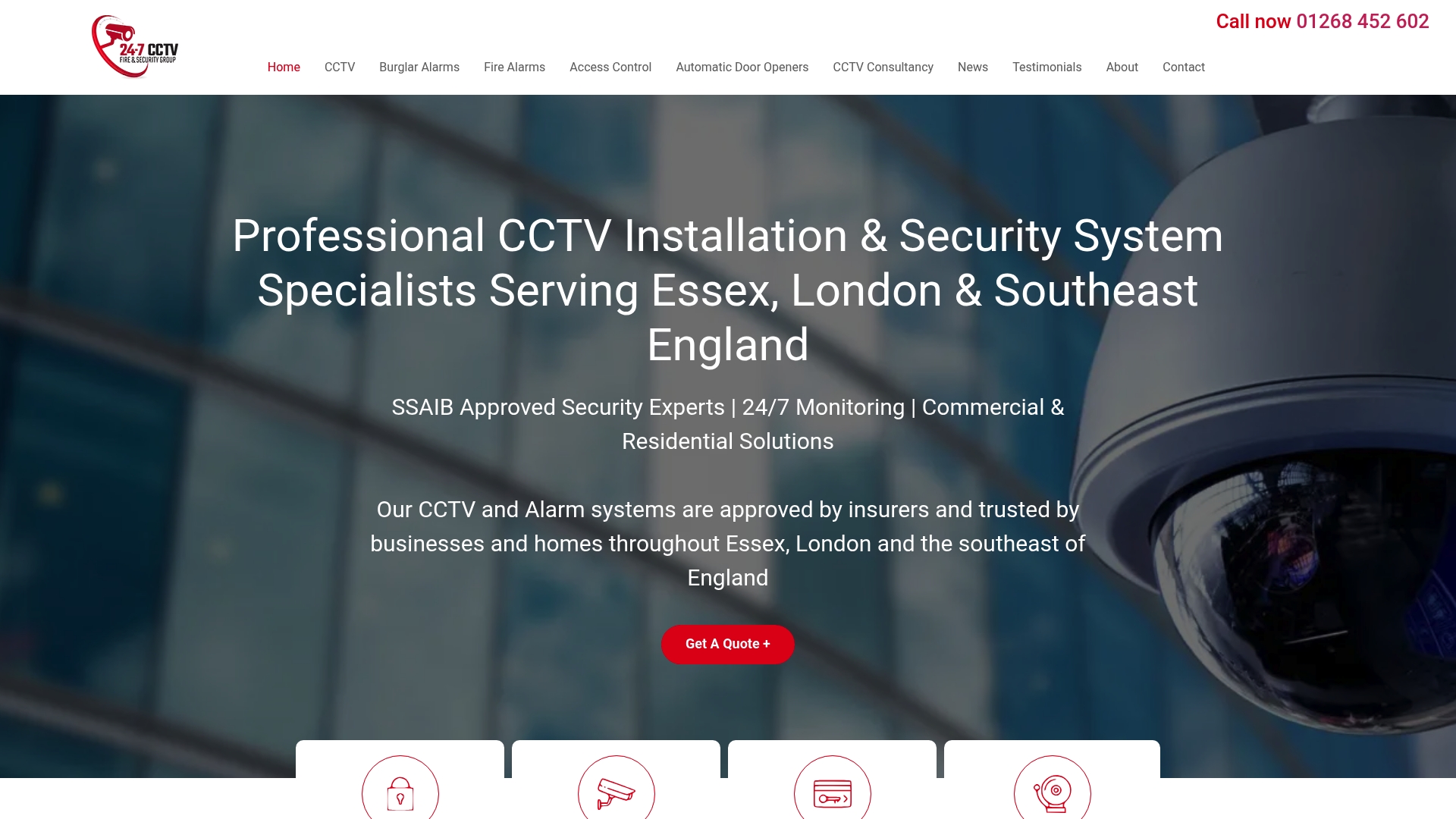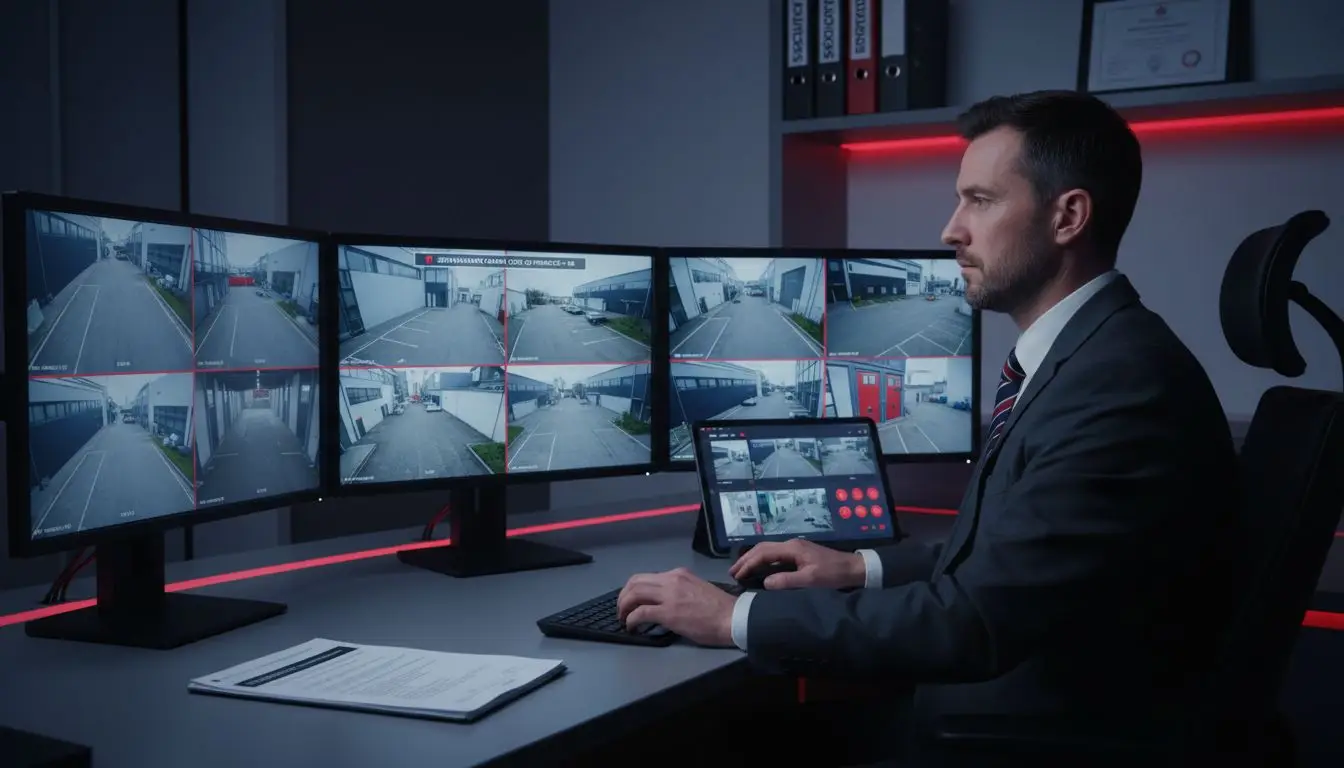Over one third of UK businesses rely on CCTV remote viewing to safeguard their property, staff, and customers every day. Security threats can appear at any moment, so having instant access to live camera feeds is no longer a luxury for most organizations. Learning how remote viewing technology works, its legal requirements, and the risks involved can help businesses protect assets, ensure compliance, and respond to incidents more effectively.
Table of Contents
- CCTV Remote Viewing Defined and Explained
- Types of Remote Viewing Systems Available
- How CCTV Remote Access Works Securely
- Legal Responsibilities for UK CCTV Monitoring
- Common Risks, Costs and Security Mistakes
Key Takeaways
| Point | Details |
|---|---|
| CCTV Remote Viewing Enhancements | This technology enables secure, real-time monitoring of premises from any internet-connected device, enhancing operational safety and control. |
| Legal Compliance is Essential | Businesses must adhere to data protection laws by ensuring transparency in surveillance practices and robust security protocols to protect individual privacy. |
| Invest in Secure Protocols | Implement robust authentication, end-to-end encryption, and regular updates to safeguard against vulnerabilities and legal issues. |
| Proactive Risk Management | Regular system audits, staff training, and maintenance are crucial to mitigate risks associated with CCTV security systems and ensure effective protection. |
CCTV Remote Viewing Defined and Explained
CCTV remote viewing is a sophisticated technology that allows businesses to monitor their premises securely from any location using internet-connected devices. This advanced surveillance method transforms traditional security systems by enabling real-time monitoring through smartphones, tablets, laptops, or dedicated monitoring screens.
According to the CCTV Monitoring Setup Guide, remote viewing provides businesses with unprecedented flexibility and control. Key features of this technology include:
- Instant access to live camera feeds
- Multiple device compatibility
- Secure encrypted connections
- Motion-activated alerts
- Cloud storage of recorded footage
As specified by the UK Government’s Surveillance Camera Code of Practice, businesses must ensure their remote viewing systems respect individual privacy and comply with data protection regulations.
This means implementing robust security protocols and being transparent about surveillance activities.
For businesses in sensitive sectors like retail, hospitality, and healthcare, remote CCTV viewing offers more than just security. It provides operational insights, enables rapid response to incidents, and creates a comprehensive monitoring strategy that protects both physical assets and organisational interests.


Types of Remote Viewing Systems Available
Modern businesses have access to several remote viewing systems that provide flexible and comprehensive surveillance solutions. These technologies range from cloud-based platforms to dedicated network infrastructures, each offering unique capabilities for monitoring and securing business premises.
According to the Wireless CCTV Explained guide, the primary types of remote viewing systems include:
Here’s a comparison of the main types of remote viewing systems for businesses:
| System Type | Key Features | Typical Devices | Notable Advantages |
|---|---|---|---|
| Cloud-Based | Real-time access Remote management | Smartphones Laptops Tablets | Easy scalability No on-site servers |
| IP Camera Network | High-resolution video Network-based | Monitoring screens Computers | Detailed footage Flexible placement |
| Hybrid System | Analogue and digital Backup support | DVR/NVR Cloud access | Cost-effective upgrades Redundancy |
| Mobile-Integrated | App control Push alerts | Smartphones Tablets | Instant notifications Remote response |
- Cloud-Based Systems: Leverage internet connectivity for real-time monitoring
- IP Camera Networks: Provide high-resolution digital surveillance
- Hybrid Systems: Combine traditional and digital monitoring techniques
- Mobile-Integrated Solutions: Enable viewing through smartphones and tablets
The UK Government’s Surveillance Camera Code of Practice emphasizes that regardless of the system type, businesses must prioritize data protection and individual privacy. This means implementing secure encryption, limiting access to authorized personnel, and maintaining transparent monitoring practices.
For businesses seeking comprehensive security, advanced remote viewing systems offer more than simple surveillance. Modern CCTV systems now integrate sophisticated features like motion detection, automated alerts, and seamless cloud storage, transforming security from a passive monitoring tool to an active risk management strategy. The right system can provide not just protection, but valuable operational insights across various business sectors.
How CCTV Remote Access Works Securely
CCTV remote access is a sophisticated security technology that enables businesses to view live and recorded footage through encrypted internet connections. The system operates through a complex network of secure digital protocols that protect sensitive visual data from unauthorized interception or manipulation.
When setting up secure remote access, businesses must follow rigorous security standards. Camera installation experts recommend implementing these critical security measures:
- Robust password authentication
- Two-factor verification
- End-to-end encryption
- Regular security software updates
- Restricted user access levels
According to the UK Government’s Surveillance Camera Code of Practice, remote access systems must prioritize data protection and individual privacy. This involves implementing strict access controls, ensuring that only authorized personnel can view surveillance footage, and maintaining comprehensive logs of all system interactions.
The technical infrastructure of secure remote access involves multiple layers of protection. Advanced systems use Virtual Private Network (VPN) technologies, secure socket layer (SSL) encryption, and continuous authentication processes to create an impenetrable digital environment. By integrating sophisticated security protocols, businesses can confidently monitor their premises while maintaining the highest standards of data protection and regulatory compliance.
Legal Responsibilities for UK CCTV Monitoring
CCTV monitoring involves complex legal obligations that businesses must carefully navigate to ensure compliance with data protection regulations. Companies using surveillance systems are required to adhere to strict legal frameworks designed to protect individual privacy and maintain ethical surveillance practices.
According to the UK Government’s data protection guidelines, businesses must fulfil several critical legal requirements when implementing CCTV systems. Maintenance and compliance experts recommend businesses take the following essential steps:
- Register with the Information Commissioner’s Office
- Pay mandatory data protection fees
- Display clear signage about surveillance areas
- Implement robust data protection protocols
- Limit footage retention periods
- Provide access to recorded data upon legitimate request
The legal responsibilities extend beyond simple registration. Employers must transparently inform workers about monitoring practices, ensuring that CCTV usage respects individual rights and follows established legal guidelines. This means providing clear communication about where cameras are located, what areas are being monitored, and the specific purposes of surveillance.
Ultimately, successful legal compliance requires a proactive approach. Businesses must continuously review their CCTV monitoring practices, maintain detailed documentation, and ensure that their surveillance strategies balance security needs with individual privacy rights. By understanding and implementing these legal responsibilities, organisations can create a secure environment that protects both their interests and the rights of individuals under surveillance.
Common Risks, Costs and Security Mistakes
CCTV security systems can become significant liabilities when businesses fail to implement them strategically. The potential risks range from technical vulnerabilities to legal non-compliance, which can result in substantial financial and reputational damage.
Uncovering the hidden risks of security systems reveals several critical vulnerabilities businesses must address:
- Outdated firmware and software
- Inadequate network security
- Poor password management
- Insufficient encryption protocols
- Lack of regular system audits
- Incomplete staff training
According to the UK Government’s Surveillance Camera Code of Practice, improper CCTV implementation can lead to significant legal consequences. Businesses may face hefty fines for data protection breaches, with penalties potentially reaching tens of thousands of pounds for serious violations.
The most effective approach involves proactive risk management. By investing in regular maintenance, comprehensive staff training, and robust cybersecurity measures, businesses can mitigate potential vulnerabilities. Implementing a strategic security framework that combines technological solutions with human expertise ensures that CCTV systems serve their primary purpose of protection without creating additional risks.
Enhance Your Business Security with Expert CCTV Remote Viewing Solutions
Managing CCTV remote viewing systems comes with challenges like ensuring secure access, maintaining legal compliance and protecting privacy while seeking real-time monitoring flexibility. Many businesses struggle with outdated technology, poor encryption, and system vulnerabilities that put their premises and data at risk. With the right CCTV system features such as encrypted remote access, secure password authentication and scalable cloud-based monitoring, you can gain full control and peace of mind.


Don’t let security gaps leave your business exposed. At 247 CCTV, we specialise in installing advanced CCTV, burglar alarms and access systems designed to meet UK data protection laws and safeguard your assets. Our expert team ensures your remote viewing setup utilises the latest encryption and user access controls for compliance and operational confidence. Discover how our professional CCTV installations offer tailored solutions backed by ongoing support. Take action now to protect your business environment and stay ahead of risks with secure, efficient CCTV monitoring.
Frequently Asked Questions
What is CCTV remote viewing and how does it work?
CCTV remote viewing is a technology that allows businesses to monitor their premises from anywhere using internet-connected devices. It operates through secure encrypted connections, providing instant access to live camera feeds and recorded footage.
What are the main types of remote viewing systems available?
The primary types of remote viewing systems include cloud-based systems, IP camera networks, hybrid systems, and mobile-integrated solutions. Each offers unique features such as real-time access, high-resolution monitoring, and flexibility in device compatibility.
How can businesses ensure the security of their CCTV remote access?
To secure CCTV remote access, businesses should implement robust password authentication, two-factor verification, end-to-end encryption, regular software updates, and restrict user access to authorized personnel only.
What legal responsibilities do businesses have regarding CCTV monitoring?
Businesses must register with the Information Commissioner’s Office, display clear signage regarding surveillance areas, implement data protection protocols, limit footage retention periods, and ensure they inform employees about monitoring practices to comply with legal requirements.
Recommended
- Latest News and Updates | 247 CCTV Security
- CCTV Monitoring Setup Guide: Secure Your Property Easily – 247 CCTV Security Ltd
- Wireless CCTV Explained: Complete Guide for UK Security – 247 CCTV Security Ltd
- Wireless CCTV Explained: Complete Guide for UK Security – 247 CCTV Security Ltd
- UK Law and smart doorbells
- How to Set Up Video Monitoring for Babies Securely | Baby Monitors for Parents

